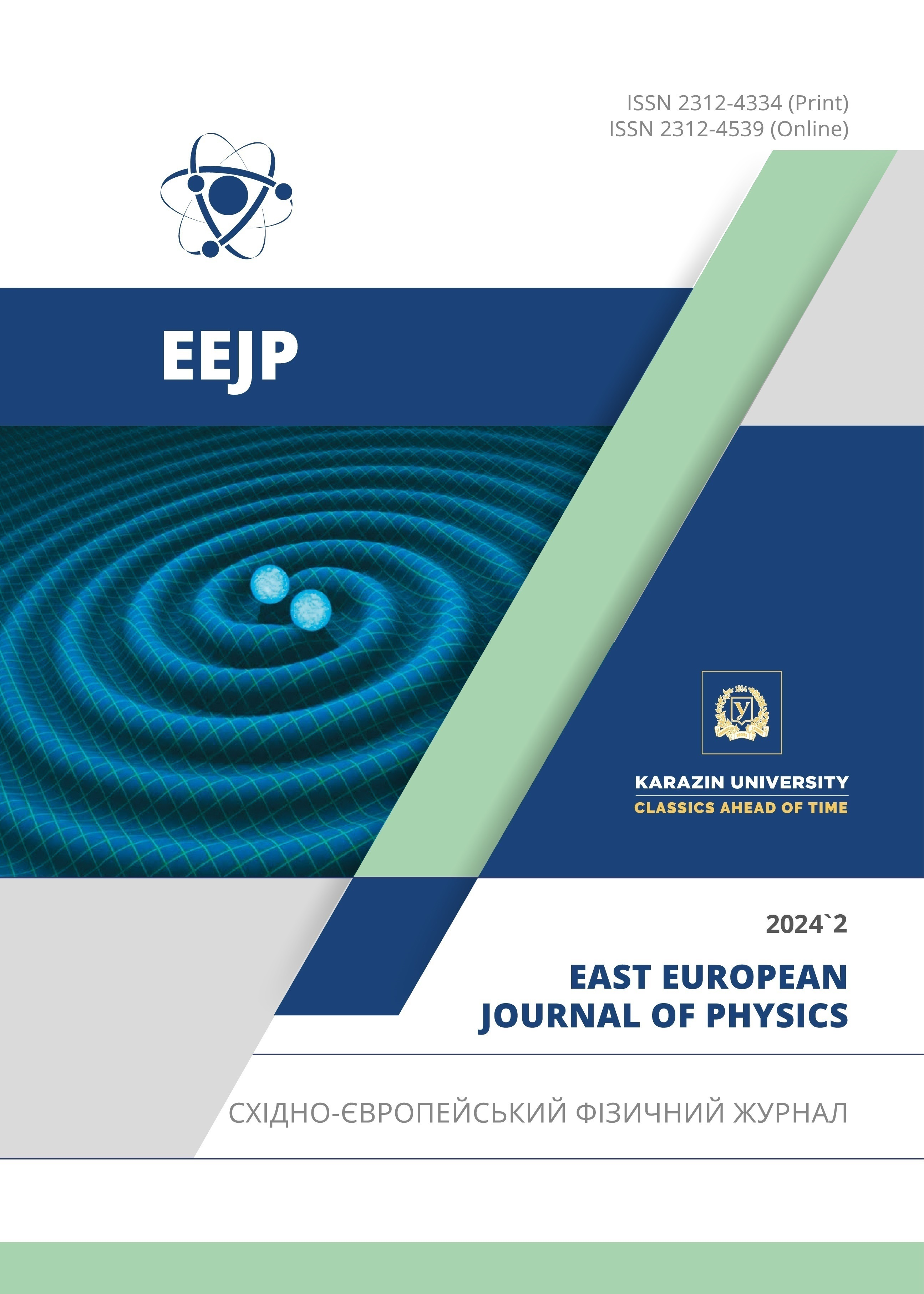Electrodifusion of Manganese Atoms in Silicon
Abstract
The paper describes the research and study of the process of electrically induced diffusion of Mn atoms in silicon directly from a Si surface layer that was preliminarily enriched with Mn. To ensure the so-called electrically induced diffusion process, a constant electric field was applied to the investigated samples. It has been revealed that as a result of the diffusion of Mn impurity atoms into samples placed at the negative pole of the electrical diffusion unit, the proportion of Mn atoms was 75.4% (relative to silicon atoms), while in samples placed at the positive pole this indicator tended to be 2.7% (relative to silicon atoms). Besides that, for the first time, an experimental increase in the electro-active concentration of Mn impurity atoms in silicon (at T = 900°C) was detected under the influence of an external constant-value electric field. In this case, the maximum solubility of impurity atoms of Mn at a temperature of T = 900°C was NMn~2.27·1014 cm-3, while the average concentration of electro-active Mn atoms diffused into silicon under the influence of an external constant electric field reached NMn*~2.62·1014 cm-3.
Downloads
References
M.K. Bakhadyrkhanov, A.Sh. Mavlyanov, U.Kh. Sodikov, and M.K. Khakkulov, “Silicon with Binary Elementary Cells as a Novel Class of Materials for Future Photoenergetics”, Applied Solar Energy, 51(4), 258–261 (2015). https://doi.org/10.3103/S0003701X1504009X
M.K. Bakhadyrkhanov, S.B. Isamov, N.F. Zikrillaev, and M.O. Tursunov, “Anomalous Photoelectric Phenomena in Silicon with Nanoclusters of Manganese Atoms,” Semiconductors, 55(6), 542–545 (2021). https://doi.org/10.1134/S1063782621060038
X.M. Iliyev, V.B. Odzhaev, S.B. Isamov, B.O. Isakov, B.K. Ismaylov, K.S. Ayupov, Sh.I. Hamrokulov, and S.O. Khasanbaeva, “X-ray diffraction and Raman spectroscopy analyses of GaSb-enriched Si surface formed by applying diffusion doping technique,” East Eur. J. Phys. (3), 363 (2023). https://doi.org/10.26565/2312-4334-2023-3-38
X.M. Iliyev, S.B. Isamov, B.O. Isakov, U.X. Qurbonova, and S.A. Abduraxmonov, “A surface study of Si doped simultaneously with Ga and Sb”, East Eur. J. Phys. (3), 303 (2023). https://doi.org/10.26565/2312-4334-2023-3-29
J. Liu, and S. Yue, “Fabrication of ZnS layer on silicon nanopillars surface for photoresistor application,” Chemical Physics Letters, 801, 139716 (2022). https://doi.org/10.1016/j.cplett.2022.139716
J. Kang, J.-S. Park, P. Stradins, and S.-H. Wei, “Nonisovalent Si-III-V and Si-II-VI alloys: Covalent, ionic, and mixed phases,” Physical Review B, 96, 045203 (2017). https://doi.org/10.1103/PhysRevB.96.045203
N.F. Zikrillaev, M.K. Khakkulov, and B.O. Isakov, “The mechanism of the formation of binary compounds between Zn and S impurity atoms in Si crystal lattice,” East Eur. J. Phys. (4), 177 (2023). https://doi.org/10.26565/2312-4334-2023-4-20
M. Niehle, J.-B. Rodriguez, L. Cerutti, E. Tournie, and A. Trampert, “On the origin of threading dislocations during epitaxial growth of III-Sb on Si(001): A comprehensive transmission electron tomography and microscopy study,” Acta Materialia, 143, 121-129 (2018). https://doi.org/10.1016/j.actamat.2017.09.055
J. Liu, M. Tang, H. Deng, S. Shutts, L. Wang, P.M. Smowton, C. Jin, et al., “Theoretical analysis and modelling of degradation for III–V lasers on Si,” Journal of Physics D: Applied Physics, 55, 404006 (2022). https://doi.org/10.1088/1361-6463/ac83d3
Y. Goswami, P. Asthana, and B. Ghosh, “Nanoscale III–V on Si-based junctionless tunnel transistor for EHF band applications,” Journal of Semiconductors, 38(5) 054002 (2017). https://doi.org/10.1088/1674-4926/38/5/054002
N.F. Zikrillayev, S.B. Isamov, B.O. Isakov, T. Wumaier, Li wen Liang, J.X. Zhan, and T. Xiayimulati, “New Technological Solution for the Tailoring of Multilayer Silicon-based Systems with Binary Nanoclusters Involving Elements of Groups III and V,” Journal of nano- and electronic physics, 15(6), 06024 (2023). https://doi.org/10.21272/jnep.15(6).06024
D. Senk, and G. Borchardt, “Solubility and Diffusivity of Manganese in Silicon at High Temperatures,” Mikrochimica Acta, 80, 477–490, (1983). https://doi.org/10.1007/BF01202026
N.A. Arutyunyan, A.I. Zaitsev, N.G. Shaposhnikov, and S.F. Dunaev, “The Thermodynamic Properties of Solid Solutions of Manganese and Iron in Silicon”, Russian Journal of Physical Chemistry A, 84(9), 1498–1501 (2010). https://doi.org/10.1134/S0036024410090086
A. Mostafa, and M. Medraj, “Binary Phase Diagrams and Thermodynamic Properties of Silicon and Essential Doping Elements (Al, As, B, Bi, Ga, In, N, P, Sb and Tl)”, Materials, 10(6), 676 (2017). https://doi.org/10.3390/ma10060676
F.A. Trumbore, “Solid Solubilities of Impurity Elements in Germanium and Silicon”, The Bell system technical journal, 39, 205 233, (1960). https://doi.org/10.1002/j.1538-7305.1960.tb03928.x
N.F. Zikrillaev, G.A. Kushiev, Sh.I. Hamrokulov, and Y.A. Abduganiev, “Optical Properties of GexSi1-x binary compounds in silicon,” Journal of nano- and electronic physics, 15(3), 03024-1 - 03024-4, (2023). https://doi.org/10.21272/jnep.15(3).03024
N.F. Zikrillaev, G.A. Kushiev, S.V. Koveshnikov, B.A. Abdurakhmanov, U.Kh. Kurbanova, and A.A. Sattorov, “Current status of silicon studies with GexSi1-x binary compounds and possibilities of their applications in electronics,” East European journal of physics, (3), 334-339 (2023). https://doi.org/10.26565/2312-4334-2023-3-34
H. Nakashima, and K. Hashimoto, “Deep impurity levels and diffusion coefficient of manganese in silicon,” Journal of Applied Physics, 69, 1440 (1991). https://doi.org/10.1063/1.347285
N.F. Zikrillaev, O. B. Tursunov, and G. A. Kushiev, “Development and Creation of a New Class of Graded-Gap Structures Based on Silicon with the Participation of Zn and Se Atoms,” Surf. Engin. Appl. Electrochem. 59(5), 670–673 (2023). https://doi.org/10.3103/S1068375523050198
N.F. Zikrillaev, S.V. Koveshnikov, S.B. Isamov, B.A. Abdurahmonov, and G.A. Kushiev, “Spectral dependence of the photoconductivity of GеxSi1–x type graded-gap structures obtained by diffusion technology,” Semiconductors, 56(1), 29-31 (2022). https://doi.org/10.1134/S1063782622020191
Copyright (c) 2024 Xalmurat M. Iliyev, Zafar B. Khudoynazarov, Bobir O. Isakov, Mirahmat X. Madjitov, Abduvokhid A. Ganiyev

This work is licensed under a Creative Commons Attribution 4.0 International License.
Authors who publish with this journal agree to the following terms:
- Authors retain copyright and grant the journal right of first publication with the work simultaneously licensed under a Creative Commons Attribution License that allows others to share the work with an acknowledgment of the work's authorship and initial publication in this journal.
- Authors are able to enter into separate, additional contractual arrangements for the non-exclusive distribution of the journal's published version of the work (e.g., post it to an institutional repository or publish it in a book), with an acknowledgment of its initial publication in this journal.
- Authors are permitted and encouraged to post their work online (e.g., in institutional repositories or on their website) prior to and during the submission process, as it can lead to productive exchanges, as well as earlier and greater citation of published work (See The Effect of Open Access).








